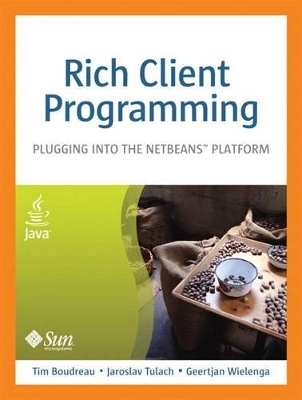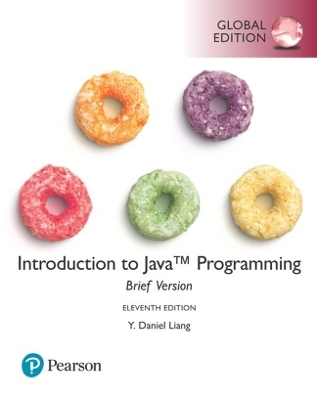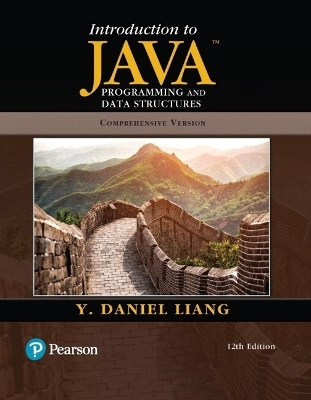
Rich Client Programming
Prentice Hall
978-0-13-235480-6 (ISBN)
- Titel ist leider vergriffen;
keine Neuauflage - Artikel merken
The open-source NetBeans Platform is an extraordinarily powerful framework for building "write once, run anywhere" rich client applications. Now, for the first time since the release of NetBeans IDE 5.0, there's a comprehensive guide to rich client development on the NetBeans Platform.
Written for Java developers and architects who have discovered that basic Swing components are not enough for them, this book will help you get started with NetBeans module development, master NetBeans' key APIs, and learn proven techniques for building reliable desktop software. Each chapter is filled with practical, step-by-step instructions for creating complete rich client applications on top of the NetBeans Platform and plugins for NetBeans IDE.
Rich Client Programming's wide-ranging content covers
Why modular development makes sense for small, medium, and large applications
Using NetBeans to accelerate development and improve efficiency
Leveraging NetBeans productivity features, from the Component Palette to Code Completion
Leveraging NetBeans' modular architecture in your own applications
Implementing loosely coupled communication to improve code maintainability and robustness
Managing user- and system-configuration data
Building reloadable components with solid threading models
Constructing sophisticated multiwindow applications and presenting rich data structures to users
Adding user-configurable options
Integrating Web services with NetBeans desktop applications
Automating module updates and providing user help
Foreword by Jonathan Schwartz
Foreword by Jan Chalupa
Preface
About the Authors and Contributors
Acknowledgments
Chapter 1: Getting Started with the NetBeans Platform
Chapter 2: The Benefits of Modular Programming
Chapter 3: Modular Architecture
Chapter 4: Loosely Coupled Communication
Chapter 5: Lookup
Chapter 6: Filesystems
Chapter 7: Threading, Listener Patterns, and MIME Lookup
Chapter 8: The Window System
Chapter 9: Nodes, Explorer Views, Actions, and Presenters
Chapter 10: DataObjects and DataLoaders
Chapter 11: Graphical User Interfaces
Chapter 12: Multiview Editors
Chapter 13: Syntax Highlighting
Chapter 14: Code Completion
Chapter 15: Component Palettes
Chapter 16: Hyperlinks
Chapter 17: Annotations
Chapter 18: Options Windows
Chapter 19: Web Frameworks
Chapter 20: Web Services
Chapter 21: JavaHelp Documentation
Chapter 22 Update Centers
Chapter 23: Use Case 1: NetBeans Module Development
Chapter 24: Use Case 2: Rich Unger on Application Development
Chapter A: Advanced Module System Techniques
Chapter B: Common Idioms and Code Patterns in NetBeans
Chapter C: Performance
Index
Tim Boudreau coauthored NetBeans™: The Definitive Guide (O'Reilly), served on the team that open-sourced NetBeans, and continues to develop for the NetBeans project. Jaroslav Tulach cofounded the NetBeans project, and remains a leading guardian of the project API. Geertjan Wielenga is the technical writer responsible for NetBeans documentation relating to module development and rich-client application development.
Foreword by Jonathan Schwartz xv
Foreword by Jan Chalupa xvii
Preface xix
About the Authors and Contributors xxvii
Acknowledgments xxxiChapter 1: Getting Started with the NetBeans Platform 11.1 Setting Up the IDE 1
1.2 NetBeans IDE Basics 3
Chapter 2: The Benefits of Modular Programming 112.1 Distributed Development 11
2.2 Modular Applications 13
2.3 A Modular Programming Manifesto 15
2.4 Using NetBeans to Do Modular Programming 19
Chapter 3: Modular Architecture 233.1 Modules—The Assembly Units of a Modular Application 23
3.2 Types of Modules 24
3.3 Module Lifecycle 29
3.4 Groups of Modules 33
Chapter 4: Loosely Coupled Communication 394.1 Registration and Discovery 39
4.2 MetaInf Services 41
4.3 The Global Lookup 43
4.4 Writing an Extension Point 46
Chapter 5: Lookup 495.1 Objects That Own Lookups 53
5.2 Lookup as a Communication Mechanism 55
5.3 Lookups and Proxying 58
5.4 Lookup and Selection 62
5.5 Writing Lookup-Sensitive Actions 63
5.6 Tracking the Global Selection 64
5.7 Legacy Variants of the Lookup Pattern in NetBeans APIs 65
5.8 Common Lookup Patterns 66
Chapter 6: Filesystems 696.1 FileSystems and FileObjects 70
6.2 What Kinds of FileSystems Will I Be Dealing With? 71
6.3 Layering 72
6.4 XML Filesystems 73
6.5 Declarative Registration II: The System Filesystem 74
6.6 Getting from FileObjects to Java Objects 88
6.7 Browsing the System Filesystem 96
6.8 Conclusions 96
Chapter 7: Threading, Listener Patterns, and MIME Lookup 1037.1 Creating the Modules and SPI 104
7.2 Implementing ListModelProvider 107
7.3 Providing a UI Component 123
7.4 Using the Pseudo Navigator 132
7.5 Conclusion: PseudoNavigator—What's Wrong with This Picture? 132
Chapter 8: The Window System 1358.1 What the Window System Does 137
8.2 Classes in the Window System API 139
8.3 Using TopComponent 141
8.4 Persisting State across Sessions 145
8.5 Window System Persistence Data 147
8.6 Creating Editor-Style (Nondeclarative) TopComponents 152
8.7 Advanced Window System Configuration: Defining Your Own Modes 153
8.8 Using TopComponent Groups 158
Chapter 9: Nodes, Explorer Views, Actions, and Presenters 1639.1 The Nodes API 164
9.2 The Explorer API 177
9.3 Actions 190
9.4 Node Properties 199
9.5 Nodes and DataObjects: Creating a System Filesystem Browser 203
9.6 Epilogue: Of Nodes, Property Sheets, and User Interface Design 205
Chapter 10: DataObjects and DataLoaders 20710.1 DataObjects: Where Do They Come From? 210
10.2 Adding Support for a New File Type 212
10.3 Using Custom File Types Internally 234
10.4 Serialized Objects and the System Filesystem 235
Chapter 11: Graphical User Interfaces 23711.1 Introduction 237
11.2 Creating a New GUI Form 240
11.3 Placing and Aligning a Component in a Form 240
11.4 Setting Component Size and Resizability 242
11.5 Specifying Component Behavior and Appearance 244
11.6 Generating Event Listening and Handling Methods 244
11.7 Customizing Generated Code 247
11.8 Building an Explorer View Visually 249
11.9 Previewing a Form 250
11.10 Using Custom Beans in the Form Editor 250
11.11 Using Different Layout Managers 251
Chapter 12: Multiview Editors 25312.1 Introduction 253
12.2 Getting Started 255
12.3 Understanding Multiview Editors 256
12.4 Creating the Editor’s Infrastructure 257
12.5 Creating the Source View 261
12.6 Creating the Visual View 269
12.7 Finishing the Sample 271
Chapter 13: Syntax Highlighting 27313.1 Introduction 273
13.2 Preparing to Create Syntax Highlighting 274
13.3 Creating Token IDs 275
13.4 Creating a Lexical Analyzer 277
13.5 Extending the Options Window 281
13.6 Registering the Syntax Highlighting in the Layer File 284
13.7 Finishing Up 286
Chapter 14: Code Completion 28714.1 Introduction 287
14.2 Understanding Code Completion 289
14.3 Code Completion Query Types 291
14.4 Preparing to Work with the CompletionProvider Interface 291
14.5 Implementing a CompletionProvider 293
14.6 Implementing a CompletionItem 296
14.7 Adding a Filter to the CompletionProvider 300
14.8 Adding Documentation to the Code Completion Box 304
14.9 Adding a Tooltip to the Code Completion Box 305
Chapter 15: Component Palettes 30715.1 Introduction 307
15.2 Adding Items to a Palette 313
15.3 Dragging and Dropping Palette Items 323
15.4 Adding Supporting Features to a Palette 331
15.5 Creating a Palette for a Text-Based Editor 344
Chapter 16: Hyperlinks 35516.1 Introduction 355
16.2 Preparing to Work with the HyperlinkProvider Class 357
16.3 Hyperlinks in Manifest Files 359
Chapter 17: Annotations 36717.1 Introduction 367
17.2 Preparing to Create an Error Annotation 368
17.3 Creating an Error Annotation 368
17.4 Preparing to Use an Error Annotation 376
17.5 Using an Error Annotation 377
17.6 Finishing Up 383
Chapter 18: Options Windows 38518.1 Introduction 385
18.2 Looking at the Options Window Extension Files 389
18.3 Creating a Primary Panel 393
18.4 Adding Settings to the Options Window 396
Chapter 19: Web Frameworks 39919.1 Introduction 399
19.2 Preparing to Work with the WebFrameworkProvider Class 404
19.3 Providing a Framework Configuration Panel 406
19.4 Creating a Source Structure 413
19.5 Letting the User Select a Library in the Frameworks Panel 423
19.6 Project Properties Dialog Box and Web Frameworks 424
19.7 Finishing Up 427
Chapter 20: Web Services 42920.1 Introduction 429
20.2 Creating and Testing a Web Service Client 430
20.3 Integrating the Web Service Client 435
Chapter 21: JavaHelp Documentation 44121.1 Creating a Help Set 442
21.2 Removing the IDE's Help Sets 446
21.3 Branding the Help Set's Default Texts 449
Chapter 22 Update Centers 45322.1 Introduction 453
22.2 Adding the IDE's Update Center Functionality 454
22.3 Creating and Distributing an Autoupdate Descriptor 456
22.4 Distributing the URL to the Autoupdate Descriptor 458
22.5 Downloading NBM Files from an Update Center 461
22.6 Publishing Updates to Existing Modules 462
Chapter 23: Use Case 1: NetBeans Module Development 46323.1 Introduction 463
23.2 Calling the External Tool 465
23.3 Handling the Output 476
23.4 Configuring the Tool 491
23.5 Formatting and Converting Files 496
23.6 Controlling the Conversion 505
Chapter 24: Use Case 2: Rich Unger on Application Development 52124.1 Introduction 521
24.2 Getting Started 522
24.3 Creating Support for the audio/wav MIME Type 526
24.4 Encapsulating Audio Data in the WavDataObject 530
24.5 Creating a Component for Viewing WAV Files 533
24.6 Converting WAV Editor to Multiview 535
24.7 Creating an API for Plugging in Additional Views 542
24.8 Implementing Your Own API to Provide a New View 544
Chapter A: Advanced Module System Techniques 551A.1 Hiding Implementation Details 551
A.2 Design for Extensibility 553
A.3 Splitting API and Implementation 555
A.4 Do I Really Need Cyclic Dependency? 559
A.5 Crossing the Informational Divide 563
A.6 Restricting Access to Friends 565
A.7 Having Public as Well as Friend API 566
A.8 A Final Word on Modularity 568
Chapter B: Common Idioms and Code Patterns in NetBeans 569B.1 Things You Do Differently in NetBeans Than in Plain Swing Code 569
B.2 Things That Represent Files 571
B.3 Working with Lookup 573
B.4 Projects 573
Chapter C: Performance 575C.1 Responsiveness versus Performance 577
C.2 Performance Tips for Module Authors 578
C.3 Writing Modules That Are Good Citizens 579
Index 583
| Erscheint lt. Verlag | 9.5.2007 |
|---|---|
| Verlagsort | Upper Saddle River |
| Sprache | englisch |
| Maße | 234 x 177 mm |
| Gewicht | 907 g |
| Themenwelt | Informatik ► Programmiersprachen / -werkzeuge ► Java |
| Mathematik / Informatik ► Informatik ► Web / Internet | |
| ISBN-10 | 0-13-235480-2 / 0132354802 |
| ISBN-13 | 978-0-13-235480-6 / 9780132354806 |
| Zustand | Neuware |
| Informationen gemäß Produktsicherheitsverordnung (GPSR) | |
| Haben Sie eine Frage zum Produkt? |
aus dem Bereich

